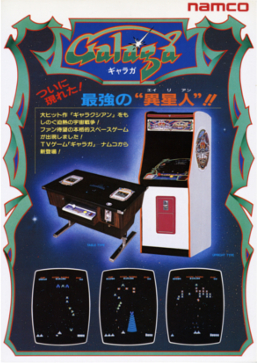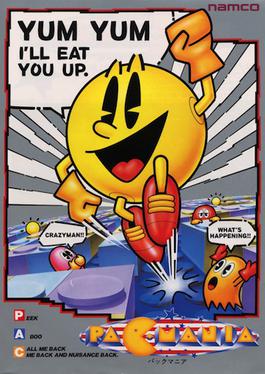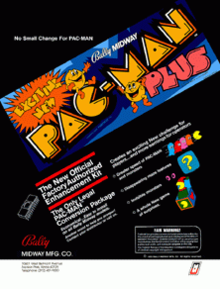
Pac-Man, originally called Puck Man in Japan, is a 1980 maze action video game developed and released by Namco for arcades. In North America, the game was released by Midway Manufacturing as part of its licensing agreement with Namco America. The player controls Pac-Man, who must eat all the dots inside an enclosed maze while avoiding four colored ghosts. Eating large flashing dots called "Power Pellets" causes the ghosts to temporarily turn blue, allowing Pac-Man to eat them for bonus points.

Namco Limited was a Japanese multinational video game and entertainment company, headquartered in Ōta, Tokyo. It held several international branches, including Namco America in Santa Clara, California, Namco Europe in London, Namco Taiwan in Kaohsiung, and Shanghai Namco in mainland China.

Ms. Pac-Man is a 1982 maze arcade video game developed by General Computer Corporation and published by Midway. It is the first sequel to Pac-Man (1980) and the first entry in the series to not be made by Namco. Controlling the title character, Pac-Man's wife, the player is tasked with eating all of the pellets in an enclosed maze while avoiding four colored ghosts. Eating the larger "power pellets" lets the player eat the ghosts, who turn blue and flee.

Galaga is a 1981 fixed shooter arcade video game developed and published by Namco. In North America, it was released by Midway Manufacturing. It is the sequel to Galaxian (1979), Namco's first major video game hit in arcades. Controlling a starship, the player is tasked with destroying the Galaga forces in each stage while avoiding enemies and projectiles. Some enemies can capture a player's ship via a tractor beam, which can be rescued to transform the player into a "dual fighter" with additional firepower.

Dig Dug is a maze arcade video game developed by Namco in 1981 and released in 1982, distributed in North America by Atari, Inc. The player controls Dig Dug to defeat all enemies per stage, by either inflating them to bursting or crushing them underneath rocks.

Pac-Man Vs. is a 2003 maze video game developed by Nintendo and published by Namco for the GameCube. In the game, one player takes control of Pac-Man, who must eat all of the pellets in the maze, while the others control the ghosts to try to catch them. The objective is to be the first to reach a set number of points, selected before the game begins. The player controlling Pac-Man uses the Game Boy Advance to play, while the others use the television to control the ghosts. The game requires the GameCube - Game Boy Advance link cable in order to play.

Jr. Pac-Man is an arcade video game developed by General Computer Corporation and released by Bally Midway on August 13, 1983. It has the same gameplay as prior entries in the series, but the maze in Jr. Pac-Man scrolls horizontally and has no escape tunnels. The bonus item which moves around the maze changes dots into a form which slows Jr. Pac-Man as they are being eaten.

Pac-Land is a 1984 side-scrolling arcade platform game developed and released by Namco. It was distributed in North America by Bally Midway, and in Europe by Atari Games. Controlling Pac-Man, the player must make it to the end of each stage to return a lost fairy back to its home in Fairyland. Pac-Man will need to avoid obstacles, such as falling logs and water-spewing fire hydrants, alongside his enemies, the Ghost Gang. Eating large flashing Power Pellets will cause the ghosts to turn blue, allowing Pac-Man to eat them for points.

Super Pac-Man is a 1982 maze chase arcade game developed and published by Namco. It was distributed in North America by Midway, and is Namco's take on a sequel to the original Pac-Man; Midway had previously released Ms. Pac-Man, which Namco had little involvement with. Toru Iwatani returns as designer.

Professor Pac-Man is a quiz arcade game that was produced by Bally Midway and is the seventh title in the Pac-Man series of games, which was released in August 1983. It is also the last of only seven games from Bally Midway Manufacturing to run on their Midway Astrocade hardware. Only 400 cabinets were made; approximately 300 of these were returned to the manufacturer and converted to Pac-Land cabinets the following year.

Pac-Man World is a platform video game developed and published by Namco for the PlayStation. Controlling Pac-Man, the player must complete each of the game's six worlds by collecting a certain amount of pellets to open up an exit door. The plot follows Pac-Man's enemies, the ghosts, crashing his 20th birthday and kidnapping his friends and family to bring them to their homeland of Ghost Island — with his birthday in ruins and his family in trouble, Pac-Man sets out to rescue them and defeat the ghosts.

Pac & Pal is a 1983 maze chase arcade game developed and published by Namco. It is part of the company's Pac-Man series and the third to have been produced in-house. Players control Pac-Man as he must eat the items in an enclosed maze while avoiding four colored ghosts that pursue him. Pac-Man is assisted by a green-colored creature named Miru, the titular "Pal", who brings the items back to the center box. Pac-Man can also collect power-ups that allow him to briefly stun the ghosts.

Namco Classic Collection Vol. 2 is a 1996 compilation arcade game developed and published by Namco. It is a collection of four of Namco's popular games: Pac-Man (1980), Rally-X (1980), New Rally-X (1981) and Dig Dug (1982). Alongside the original games, three new "Arrangement" games based on each game are included.

Pac-Man is a 1982 maze video game developed and published by Atari, Inc. under official license by Namco, and an adaptation of the 1980 hit arcade game of the same name. The player controls the title character, who attempts to consume all of the wafers in a maze while avoiding four ghosts that pursue him. Eating flashing wafers at the corners of the screen causes the ghosts to temporarily turn blue and flee, allowing Pac-Man to eat them for bonus points. Once eaten, a ghost is reduced to a pair of eyes, which return to the center of the maze to be restored.

Pac-Mania is a cavalier perspective maze game that was developed and released by Namco for arcades in 1987. In the game, the player controls Pac-Man as he must eat all of the dots while avoiding the colored ghosts that chase him in the maze. Eating large flashing "Power Pellets" will allow Pac-Man to eat the ghosts for bonus points, which lasts for a short period of time. A new feature to this game allows Pac-Man to jump over the ghosts to evade capture. It is the ninth title in the Pac-Man video game series and was the last one developed for arcades up until the release of Pac-Man Arrangement in 1996. Development was directed by Pac-Man creator Toru Iwatani. It was licensed to Atari Games for release in North America.

Pac-Man Battle Royale is a 2010 maze battle-royale arcade game in the Pac-Man series. Developed and published by Namco Bandai Games, it was made in celebration of Pac-Man's 30th Anniversary. The game sees up to four players control multi-colored Pac-Men as they try to compete to be the last Pac-Man standing.

3D Maze Man: Amazing Adventures is a 1998 video game for Microsoft Windows unofficially based on Namco's Pac-Man games and character. In 2000, Pac-Man licensee Hasbro sued to prevent the production and distribution of this and other eGames' other offerings, which included a Tetris-inspired game. Per the settlement, sales continued until the end of September 2000.

Pac-Man Championship Edition 2 is a maze arcade game in the Pac-Man series which was released for PlayStation 4, Windows, and Xbox One on September 15, 2016; an updated version featuring an exclusive 2-player co-op mode, Pac-Man Championship Edition 2 Plus, was released for Nintendo Switch on February 22, 2018. It was developed and published by Bandai Namco Entertainment, and is a direct sequel to Pac-Man Championship Edition, making it an indirect follow-up of Pac-Man Championship Edition DX+.

The Pac-Man 40th Anniversary was a celebration of the Pac-Man series of video games since the release of the arcade cabinet Pac-Man on May 22, 1980. Bandai Namco celebrated the anniversary through business ventures with video games, events, clothing and other forms of merchandise. The anniversary took place throughout 2020, and ended in early 2021.



















